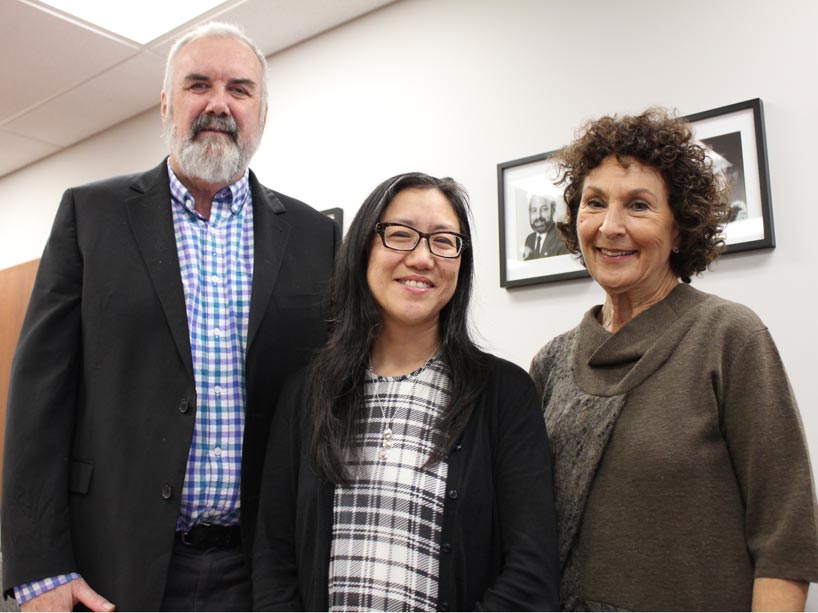Artist-in-residence Taien Ng-Chan discusses the "poetics of mapping"

Photo: Hamilton-based artist Taien Ng-Chan (centre, with FCS professor Ken Moffatt and John C. Eaton Chair Melanie Panitch) melds cinema, poetry, cartography, found and digital art to interrogate everyday urban life.
What is the ideology of a map? What makes a landmark worthy of the status? Are there more complex ways to imagine the urban landscape? Hamilton-based artist Taien Ng-Chan, the Faculty of Community Service’s first artist-in-residence, discussed these ideas and more on November 9 as part of FCS’s Community Transformation Café series.
Noting that Google Maps has become the default map for most of us, Taien observed, “It presents a very particular view of the urban landscape. The kinds of places that it shows are all places to spend your money. The view of the landscape is capitalist and consumerist: where can you go to eat, where can you buy things, and landmarks. A very official and consumerist view of the land.”
What are some other approaches to mapmaking? Taien cited a range of contemporary artists engaged in “poetic mapping:” Denis Wood, whose book Everything Sings: Maps for a Narrative Atlas maps his North Carolina neighbourhood to show where to find streetlights, wind chimes, jack-o-lanterns, and other objects; and graphic novelist Ben Katchor, who mapped all the puddles on his street (“Because, y’know, they do appear in the same places every time it rains…” said Taien).
With the Hamilton Perambulatory Unit—the artists’ collective she co-founded—Taien and her colleagues have experimented with creative forms of cartography. For their “Google Map City Centre Drift,” they explore the arbitrary locations that Google Maps pinpoints as the city centres. For their synesthesia map of the Hamilton Farmer’s Market, they mapped the area through its smells. Other projects include experiments in auto-cartography. “Your route is like a self-portrait. Everybody has different practices. Some people take the same streets all the time; other people try to do different things, take different streets. That’s very linked with our own subjectivities and how you co-create space.”
One of her most recent ambitious works is her “Stratigraphic City,” currently on display at the Art Gallery of Windsor. The exhibit features a diorama of the city of Windsor; if patrons wave their hands over it, several layers of digital images will appear depicting maps and images sourced by Google: “What do you know about a city before you actually visit it? You don’t know anything. So you generally do a Google search.” The highest layer is “the poetic layer, where I have hand-drawn animations and little poems I’ve written about Windsor, which I gathered while doing research. It’s an idea of how to experience space.”
As a writer and media artist, Taien’s work melds cinema, poetry, cartography, found and digital art to interrogate everyday urban life. Her current project, “The Trajectories of Things,” moves away from mapping and towards objects. She invites participants to share memories of objects in their lives that have no practical use or value, but that the participants still love. “It’s exploring the idea of things that don’t have any practical use or economic value—but still have memory value. A very anti-neoliberal value, and poetic worth.”
Discussing her own childhood as a latchkey kid, Taien remembered the rice cooker that her mother taught her to use, which she often used to make meals after school. “When I moved out, I was 17, and she gave me this rice cooker to take with me. I love this rice cooker. But I don’t have it anymore, but I did have it for years and years, and I moved place to place with it, and I used it so much it wore a little hole in the metal pot. I was like, ‘Can I get this fixed?’ And people said, ‘No, not really.’”
The community is invited to participate in “The Trajectories of Things (external link) ”.
